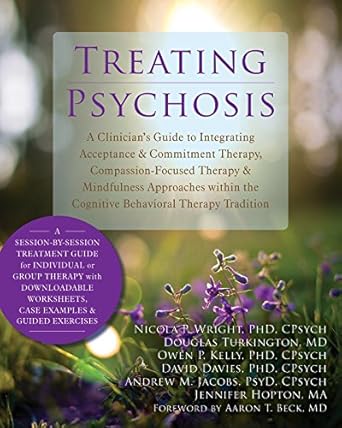If you’re a mental health professional seeking effective strategies to support your clients affected by psychosis, look no further than “Treating Psychosis: A Clinician’s Guide to Integrating Acceptance and Commitment Therapy, Compassion-Focused Therapy, and Mindfulness Approaches.” This invaluable resource combines evidence-based practices within the cognitive behavioral therapy (CBT) framework, offering you innovative techniques to enhance your therapeutic repertoire. With session-by-session clinical interventions, this guide is designed for individual or group settings, whether inpatient, outpatient, or within the community.
What sets this book apart is its compassionate and de-stigmatizing approach, which prioritizes the values and goals of your clients. Featuring 40 reproducible clinical practice forms and a companion website with additional resources, “Treating Psychosis” equips you with the tools necessary to empower your clients and help them attain meaningful lives. Dive into a wealth of knowledge informed by extensive clinical experience, and discover how to partner with your clients in overcoming challenges and achieving their valued aspirations.
Treating Psychosis: A Clinician’s Guide to Integrating Acceptance and Commitment Therapy, Compassion-Focused Therapy, and Mindfulness Approaches within the Cognitive Behavioral Therapy Tradition
Why This Book Stands Out?
- Comprehensive Integration: This guide uniquely combines Acceptance and Commitment Therapy (ACT), Compassion-Focused Therapy (CFT), and mindfulness approaches within the Cognitive Behavioral Therapy (CBT) framework, providing a holistic treatment strategy for psychosis.
- Evidence-Based Practice: Rooted in extensive research and clinical experience, the book offers scientifically-backed interventions that empower clinicians to effectively support their clients.
- Practical Tools: With 40 reproducible clinical practice forms and a companion website filled with downloadable resources, guided exercises, and case examples, it equips mental health professionals with practical tools for real-world application.
- Client-Centered Approach: The therapeutic strategies prioritize the client’s values and goals, promoting a compassionate and de-stigmatizing environment that fosters meaningful therapeutic partnerships.
- Versatile Application: The guide is designed for use in various settings—whether inpatient, outpatient, or community-based—making it an essential resource for clinicians across different practice environments.
- Session-by-Session Guidance: Provides detailed, step-by-step interventions for individual and group treatments, ensuring that clinicians can implement effective strategies tailored to their clients’ needs.
Personal Experience
As I delved into the pages of Treating Psychosis, I found myself reflecting on the profound impact that mental health issues can have, not only on individuals but also on their loved ones. It’s a journey that many can relate to, whether personally or through someone dear to them. This book resonates deeply, offering insights that feel both compassionate and empowering.
Reading through the guide, I was struck by how it emphasizes the integration of Acceptance and Commitment Therapy, Compassion-Focused Therapy, and mindfulness within the framework of Cognitive Behavioral Therapy. This holistic approach feels refreshing and hopeful, especially when dealing with the complexities of psychosis. It’s easy to feel overwhelmed by traditional treatment methods, but the strategies laid out in this book bring a sense of clarity and direction.
- Empathy and Understanding: The book’s compassionate approach reminds us that those experiencing psychosis are not defined by their symptoms. Instead, they are individuals with unique stories and dreams, deserving of respect and understanding.
- Practical Tools: I appreciated the inclusion of session-by-session interventions and reproducible clinical forms. These resources provide tangible tools that can be used in real-life scenarios, making the therapeutic process more accessible for both clinicians and clients.
- Fostering Connection: The emphasis on partnership in developing therapeutic strategies struck a chord with me. It highlights the importance of collaboration in therapy, where clients are not just passive recipients but active participants in their healing journey.
- Valued Goals: The focus on helping individuals work toward their valued goals resonates with anyone who has faced challenges. It serves as a reminder that, despite the hurdles, there is always a path toward a more meaningful life.
In a world that often stigmatizes mental health issues, Treating Psychosis stands out as a beacon of hope and understanding. It encourages readers to embrace a compassionate perspective, transforming how we view and approach psychosis. This book is not just a guide for professionals; it’s a heartfelt invitation to foster empathy and connection in the world around us.
Who Should Read This Book?
If you’re a mental health professional looking to deepen your understanding of psychosis and enhance your therapeutic toolkit, then Treating Psychosis is tailor-made for you. This book is not just a guide; it’s a comprehensive resource that equips clinicians with evidence-based strategies to support individuals grappling with psychotic experiences.
Here’s why this book is perfect for you:
- Psychologists and Therapists: Whether you work in a clinical setting or a community health environment, this book provides session-by-session interventions that can be readily applied in your practice.
- Graduate Students: If you’re studying psychology or counseling, this book offers valuable insights and techniques that will enrich your academic knowledge and practical skills.
- Social Workers: For those in the field of social work, the compassionate and strengths-based approaches in this guide can enhance your ability to support clients in distress.
- Psychiatrists: While medication is vital, integrating psychotherapy can lead to more holistic care for your patients. This book bridges that gap with effective strategies.
- Group Facilitators: If you lead group therapy sessions, the reproducible clinical practice forms and case examples will help you design impactful programs for individuals affected by psychosis.
This book stands out because it emphasizes a compassionate, de-stigmatizing approach, integrating Acceptance and Commitment Therapy (ACT), Compassion-Focused Therapy (CFT), and mindfulness within the Cognitive Behavioral Therapy (CBT) tradition. By focusing on clients’ values and goals, it empowers both you and your clients to navigate the challenges of psychosis together. Plus, with access to a companion website loaded with additional resources, you’re never alone on this journey.
In short, if you are committed to making a positive impact in the lives of those affected by psychosis, Treating Psychosis is a must-read that will elevate your practice and transform your therapeutic relationships.
Treating Psychosis: A Clinician’s Guide to Integrating Acceptance and Commitment Therapy, Compassion-Focused Therapy, and Mindfulness Approaches within the Cognitive Behavioral Therapy Tradition
Key Takeaways
This book, “Treating Psychosis,” offers invaluable insights and practical guidance for mental health professionals working with individuals experiencing psychosis. Here are the most important lessons and benefits readers can expect:
- Comprehensive Treatment Framework: Integrates Acceptance and Commitment Therapy (ACT), Compassion-Focused Therapy (CFT), and mindfulness approaches within the Cognitive Behavioral Therapy (CBT) tradition.
- Evidence-Based Practices: Grounded in robust research and clinical experience, ensuring effective strategies for treating psychosis.
- Session-by-Session Interventions: Provides detailed clinical interventions suitable for individual or group therapy in various settings, including inpatient and outpatient care.
- Practical Tools: Features 40 reproducible clinical practice forms and a companion website with downloadable resources, guided exercises, and case examples.
- Empowering Approach: Emphasizes a compassionate and strengths-oriented method, placing clients’ values and goals at the forefront of therapy.
- Enhanced Client Outcomes: Aims to help clients develop effective strategies for managing symptoms and pursuing meaningful life goals.
- De-Stigmatizing Perspective: Promotes a compassionate and understanding approach that reduces stigma associated with psychosis, fostering a supportive therapeutic environment.
Final Thoughts
If you are a mental health professional seeking to enhance your understanding and effectiveness in treating psychosis, “Treating Psychosis: A Clinician’s Guide to Integrating Acceptance and Commitment Therapy, Compassion-Focused Therapy, and Mindfulness Approaches within the Cognitive Behavioral Therapy Tradition” is an essential resource for your collection. This comprehensive guide not only offers evidence-based strategies rooted in cognitive behavioral therapy but also integrates innovative approaches like ACT, CFT, and mindfulness to address the complex needs of individuals affected by psychosis.
The book provides:
- Session-by-session clinical interventions for both individual and group settings.
- A wealth of reproducible clinical practice forms to streamline your therapeutic process.
- Access to a companion website with additional resources, guided exercises, and case examples.
- A compassionate and empowering approach that emphasizes client values and goals.
With its foundation in theory, research, and extensive clinical experience, “Treating Psychosis” equips clinicians with the tools they need to foster meaningful change in their clients’ lives. It is not just a guide; it is a pathway towards a more compassionate and effective practice.
Don’t miss the opportunity to transform your therapeutic approach and enhance the lives of those you serve. Purchase your copy today!





